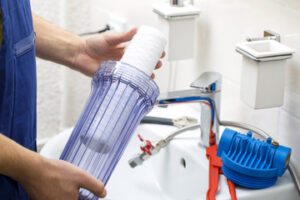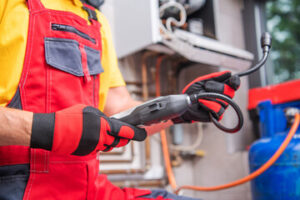Water is a necessity for life, but it can be subjected to contaminants that can cause illness or even death. Luckily, water filtration can help keep harmful substances from reaching your body.
From rain, snow, and runoff to lakes, rivers, and aquifers, water has plenty of opportunities to pick up organisms, particles, and chemicals. To keep these pollutants at bay, consider one of our top picks for home Water Filtration Atlanta systems.

Physical Filtration
Filtration is a process that separates particles or molecules from a liquid, resulting in the collection of the separated material (residue) and the passage of the liquid through the filter. This separation is based on size, shape, or charge and is used in a wide range of laboratory applications including sample preparation and reducing the background signals to increase the signal-to-noise ratio of analytical tests.
Mechanical filtration is the physical process of removing sediment, silt, and any other unwanted particles from water by using a barrier that selectively traps material from the current stream. This can be a simple substrate such as gravel or rock, a sponge, a woven cotton floss, or even a diatomaceous earth powder. These filters will clog over time and require regular cleaning or replacement.
Membrane filtration uses semipermeable membranes to separate fluids by creating a type of equilibrium where the fluid with a lower concentration of solutes attempts to move to the side with higher solutes. This can be done by applying pressure to one side of the membrane or by allowing gravity to create a natural flow toward the area with lower solutes. This allows for the removal of large amounts of water and other materials from the solution such as magnesium and calcium ions, dissolved viruses and bacteria, silica, and many other contaminants from drinking water.
A membrane filter typically has a barrier layer with high surface porosity that contains directional water channels. This layer is usually referred to as the “feeding layer” or “filter cake.” The porosity of the feeding layer and the pore structure are important to the overall performance of a membrane.
The membrane itself can be made from a variety of materials including polymeric (polyimide and polyvinyl chloride) and ceramics. Polymeric membranes are generally preferred for industrial filtration because they can be produced inexpensively, and have good mechanical properties and good chemical resistance. Ceramic membranes are also widely used for ultra-filtration and may be incorporated into devices such as reverse osmosis.
Depending on the membrane type it can be important to consider how the bed will be hydraulically backwashed. As the density of a filter bed increases due to accumulated detritus this can lead to increased resistance to flow and in some cases hydraulic disruption. Two techniques that help to limit this hydraulic disruption are the Immedium filter and the Biflow filter.
Chemical Filtration
A filtration system that relies on chemical reactions rather than physical barriers to filter water is called chemical filtration. This includes ion exchange and membrane filters. These are usually used for drinking water or sewage and can remove particles as small as a single micron. They can also eliminate giardia and cryptosporidium cysts. The other big advantage of chemical filtration is that it can be used for removing toxic materials and vapors, like volatile organic compounds (VOCs), from water.
VOCs are a significant health risk because they can lead to nose, throat, and eye irritation. They can also cause dizziness, headaches, and rashes. Chemical filtration uses activated carbon to trap and inactivate bacteria, viruses, and other harmful pathogens. This type of filtration is also very effective in eliminating bad odors and chemicals from the water supply.
Another important use of chemical filtration is to reduce dissolved substances, including phosphates and nitrates. These are often the result of excess fertilizer and runoff from agricultural fields. Chemical filtration can help lower nutrient levels in the water, making it healthier for plants and animals.
One other common form of chemical filtration is the use of aeration devices to break down large particles in water and reduce their size. This helps to prevent the formation of flocs and other bacterial debris that can clog tanks and other equipment.
Many people confuse chemical filtration with water softening, but they are not the same. Filtration deals with specific contaminants and water quality issues while softening removes different materials, like calcium and magnesium that cause hard water. This can reduce mineral deposits and staining in pipes, as well as brittle dishes and dry skin.
There are plenty of products out there that claim to be a form of chemical filtration. It is important to read labels carefully because some products will alter pH or hardness, add phosphates, or have other undesired effects. Others contain both high-grade activated carbon and a proprietary blend of resins to provide superior chemical filtration. This product removes ammonia, nitrates, phosphates, and heavy metals and is available in both freshwater and saltwater versions.
Reverse Osmosis
Reverse osmosis uses a semi-permeable membrane to let water pass while trapping salt, organics, and other impurities. Originally developed to desalinate seawater, reverse osmosis is now a common household filtration technique for many who drink bottled water (and want the health benefits of ultra-pure water).
Because it filters on a molecular level, this type of system removes more dissolved substances than most other types of filtration systems do. It also removes microorganisms and toxins from the water, making it safer to drink for those with sensitive stomachs or digestive tracts. Reverse Osmosis also reduces odors and unpleasant tastes in the water.
While this method can be expensive to run, it can save money and help the environment by reducing the number of disposable plastic bottles sent into landfills each year. A reverse osmosis system can also be more energy-efficient than an evaporative system that requires steam and electrical power to force the water through the membrane at high speed.
Some reverse osmosis systems require the use of a separate water softener to keep the membrane from becoming blocked by hard minerals that are found in tap water. The water softener helps to reduce the amount of calcium and other minerals that are left behind on the membrane, extending its lifespan.
One of the drawbacks of reverse osmosis is that it wastes a lot of water in the process, but this can be lessened by using a postfilter to re-harvest the rejected water. The same high pressure that forces the water through the membrane can be used to power pumps to reuse the rejected water.
Another concern is biofouling, the buildup of microorganisms on a reverse osmosis membrane that can cause the system to stop working properly. While this problem is less of a concern for those who live in areas with clean city water, those on well water should be wary of the potential of their system becoming contaminated by microorganisms.
Reverse osmosis can produce great-tasting, clean water, but it’s important to know what your goals are for the system before you decide whether this is the best option for your home. Reverse osmosis can also be a poor choice for households that plan to use the water in fish tanks or other aquatic environments, as it removes the essential salts and minerals that fish and plants need to thrive.
Disinfection
As water travels through ecosystems, it has plenty of chances to pick up minerals, sediment, and other materials. In nature, this is not a bad thing, but it can pose a problem when the water reaches our homes. That is why filtration is so important to keep water pure.
The main reason we disinfect water is to kill harmful pathogens that may get through filters. Pathogens include viruses, bacteria (such as Salmonella, Cholera, and Campylobacter), and protozoa (including Giardia and Cryptosporidia). Chemical disinfectants are often used to kill microorganisms in drinking water treatment systems. However, these disinfectants can also create toxic byproducts of oxidation (known as disinfectant-associated chemical pollutants or DBPs) when they react with naturally occurring organic matter in the water. These DBPs can be trihalomethanes (THMs), haloacetic acids (HAAs), or haloacetonitriles (HANs).
Water purification uses methods like screening, filtration, distillation, and disinfection to reduce the concentration of particles, parasites, and other contaminants in the water. The process of reducing these contaminants can make it safer and more pleasant to drink, and it also makes it less likely that the water will carry harmful microorganisms.
Screen filters are often the first step in water filtration and are designed to filter out the largest particles and contaminants from tap water, such as sand, silt, and microorganisms. Membrane filters are a more advanced form of filtration that can trap substances down to a fraction of a nanometer in size. Membrane filtration is often used to remove chemicals and microorganisms from water that have already been treated using other types of filtration, including reverse osmosis and UV disinfection.
For people who need to treat water for a specific purpose, such as drinking, cooking, or bathing, Point of Use (POU) filtration can be the best option. POU water treatments are typically small countertop and under-sink devices that use a combination of filters and disinfection to produce clean, safe drinking water for the individual user.
People with compromised immune systems are especially vulnerable to infection from contaminated water. To help protect against infection, they should use a filtration system that can effectively reduce germs like viruses and bacteria, such as systems that have an absolute 1-micron pore size and NSF standards 53 or 58.

